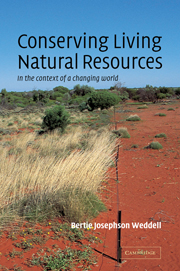Book contents
- Frontmatter
- Contents
- Preface
- Introduction: Balance and flux
- Methodology: Getting the information we need to manage living natural resources
- Part I Management to maximize production of featured species – a utilitarian approach to conservation
- 1 Historical context – the commodification of resources and the foundations of utilitarian resource management
- 2 Central concepts – population growth and interactions between populations
- 3 Central concepts – habitats
- 4 Techniques – harvest management
- 5 Techniques – habitat management
- 6 Techniques – management to minimize conflicts between pest species and people
- Part II Protection and restoration of populations and habitats – a preservationist approach to conservation
- Part III Management to maintain processes and structures – a sustainable-ecosystem approach to conservation
- Postscript
- Appendix: Scientific names of organisms mentioned in the text
- Index
1 - Historical context – the commodification of resources and the foundations of utilitarian resource management
Published online by Cambridge University Press: 05 June 2012
- Frontmatter
- Contents
- Preface
- Introduction: Balance and flux
- Methodology: Getting the information we need to manage living natural resources
- Part I Management to maximize production of featured species – a utilitarian approach to conservation
- 1 Historical context – the commodification of resources and the foundations of utilitarian resource management
- 2 Central concepts – population growth and interactions between populations
- 3 Central concepts – habitats
- 4 Techniques – harvest management
- 5 Techniques – habitat management
- 6 Techniques – management to minimize conflicts between pest species and people
- Part II Protection and restoration of populations and habitats – a preservationist approach to conservation
- Part III Management to maintain processes and structures – a sustainable-ecosystem approach to conservation
- Postscript
- Appendix: Scientific names of organisms mentioned in the text
- Index
Summary
When we conserve biological, that is living, natural resources such as wild plants and animals, we make decisions about their use, management, or protection in order to prevent their depletion and insure that they will continue to be around in the future. In this chapter we will look at the historical conditions that created a need for a formal approach to natural resource conservation in the western world and its colonies. We will see how the disciplines of wildlife management, forestry, and range management arose in response to threats to living natural resources that followed the commodification of resources in Europe, the Americas, Africa, Asia, and the Australian region. These disciplines are utilitarian in their approach; they focus on the exploitation of economically valuable species. The word “exploitation” has several connotations. To exploit a resource is to use it, but the term often carries an implication of excessive use, unfair use, or use without appropriate compensation. In this book, the term exploitation is meant to be synonymous with utilization, without a connotation of exorbitant or inappropriate use. We will, however, see many cases of unregulated or excessive exploitation that resulted in resource depletion or environmental degradation. All societies, of course, use living natural resources, and thus they are utilitarian in their approach to those resources (although this is not necessarily the only way that they relate to the natural world).
- Type
- Chapter
- Information
- Conserving Living Natural ResourcesIn the Context of a Changing World, pp. 29 - 59Publisher: Cambridge University PressPrint publication year: 2002



